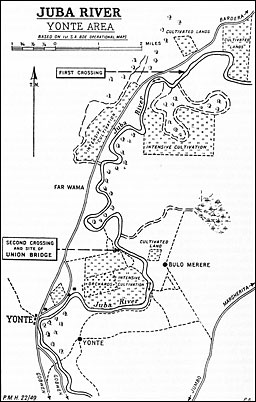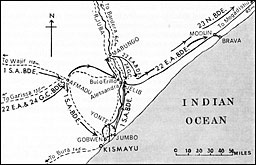
15
Rolling up the Juba Line
In the midst of his operations to capture Kismayu General Cunningham had received a signal, dated 12 February, 1941, from General Wavell informing him of the situation and stating: Tn East Africa capture of Mogadishu would complete isolation of Italian East Africa and hasten surrender and should be carried out after capture Kismayu provided it does not involve heavy commitment. Vital importance of support of Greece and Turkey must however be overriding consideration.'1 As operations in southern Abyssinia were now thought never likely to be decisive, General Cunningham was being asked if the South African Division could be withdrawn. It was assumed that no major operation except possibly the capture of Mogadishu would be required after the fall of Kismayu. And already it was hoped that quick victory in East Africa might deter Japan from aggression.
Any further move was dependent upon crossing the Juba River, which was 580 feet wide at Gobwen and tidal for 14 miles, but could be waded at Jelib and at some points north of it. General Cunningham's information was that General de Simone had his motorized 15th Amhara Brigade (General Brunelli) in reserve in the Jelib area.2 It was actually at Brava and on 17 February was placed at the disposal of 102nd Colonial Division3 while two of the three Dubat groups in the Jelib subsector were moved back from Dinsor to Modun.
General Cunningham realized that the enemy could not possibly defend every yard of the long river and he urged General Godwin-Austen to tap in all along and seize possible bridgeheads--which the high degree of motorization in the division made feasible. If 12th African Division were not successful, General Cunningham was even prepared to bring up 11th African Division and place the attacking force on a two-divisional front to increase its chances of finding a suitable crossing place.
The 27th Road Construction Company, S.A.E.C. was very soon improving the satellite landing ground at Gobwen for use by the South African Air Force,4 and at a conference there on 15 February General Cunningham stressed that the river had to be crossed that day or the day following at the very latest.
Brigadier Pienaar, whose initiative had so far been restricted by his orders from 12th African Division, then undertook to effect a crossing providing Divisional Headquarters agreed. General Cunningham

